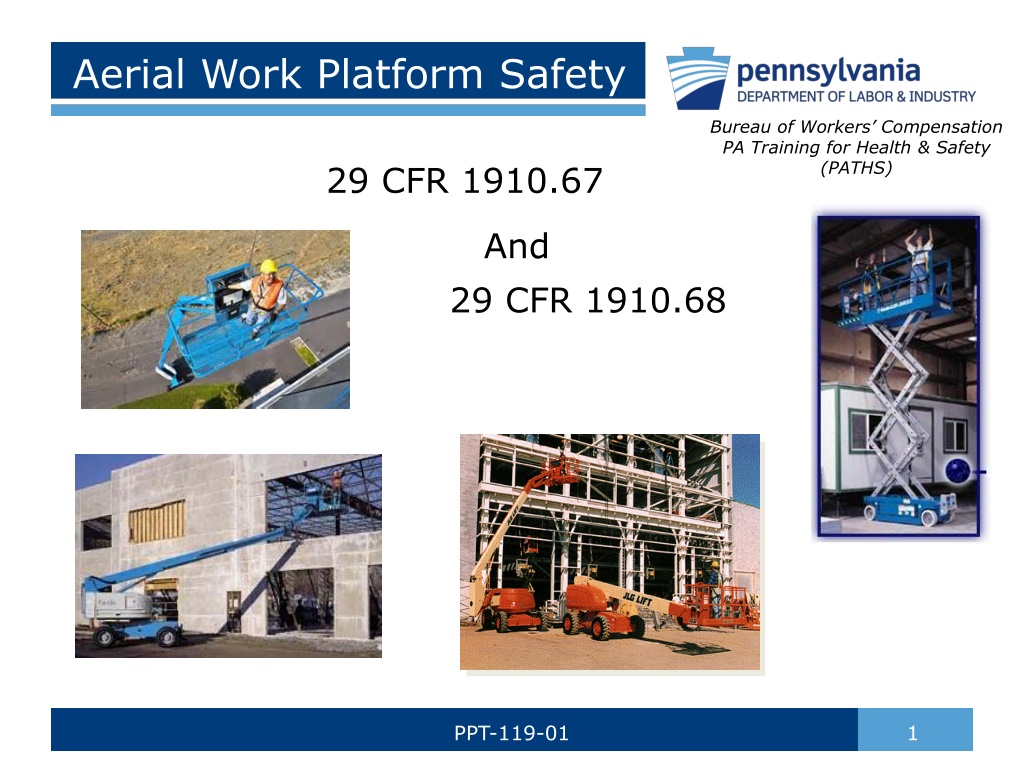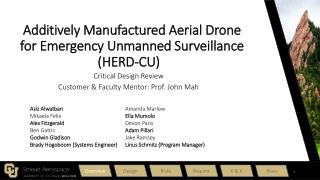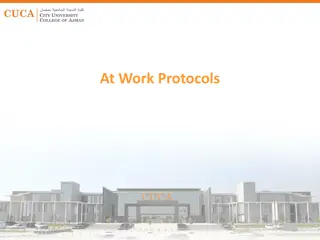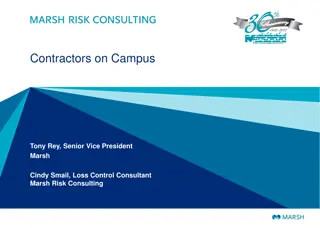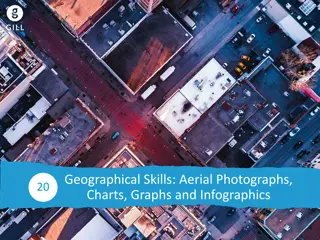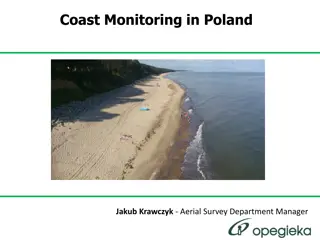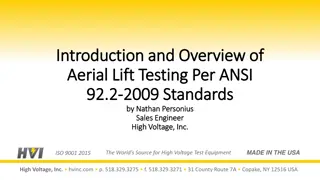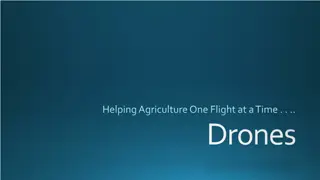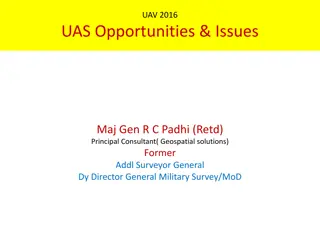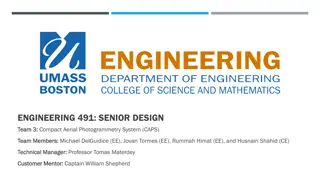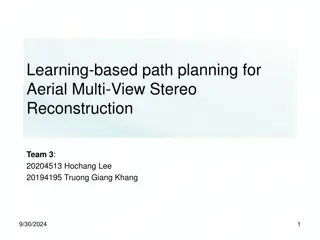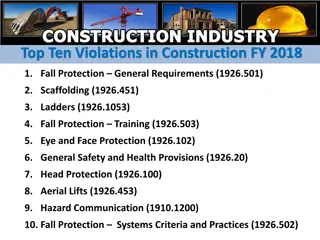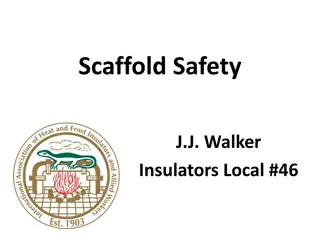Aerial Work Platform Safety Training Guidelines
A comprehensive overview of aerial work platform safety guidelines providing insights on operator training requirements, inspection protocols, maintenance needs, and statistics on aerial lift incidents such as falls, tip-overs, and electrocutions. Emphasizes the importance of qualified personnel for training and operational compliance.
Download Presentation

Please find below an Image/Link to download the presentation.
The content on the website is provided AS IS for your information and personal use only. It may not be sold, licensed, or shared on other websites without obtaining consent from the author.If you encounter any issues during the download, it is possible that the publisher has removed the file from their server.
You are allowed to download the files provided on this website for personal or commercial use, subject to the condition that they are used lawfully. All files are the property of their respective owners.
The content on the website is provided AS IS for your information and personal use only. It may not be sold, licensed, or shared on other websites without obtaining consent from the author.
E N D
Presentation Transcript
Aerial Work Platform Safety Bureau of Workers Compensation PA Training for Health & Safety (PATHS) 29 CFR 1910.67 And 29 CFR 1910.68 PPT-119-01 1
Objectives Operator Training Requirements Before Operation Inspection Safety Operations of a Lift Aerial Lift Requirements Scissors Lift Requirements Maintenance Requirements PPT-119-01 2
Aerial Lift Deaths % of Deaths 43% Electrocutions 11% 26% Falls 44% 17% Collapses/tipovers 30% 7% Caught in/between Boom-supported lifts = 144 deaths # Scissor lifts = 64 deaths 5% Struck by/against 9% #Data for scissor lifts do not meet Bureau of Labor Statistics publication criteria Source: U.S. Bureau of Labor Statistics data PPT-119-01 3
Aerial Lifts Falls 1/5 of deaths involved ejections, after being struck by object Cause of fall unknown in 3/5 of deaths Other causes included removal of chains, standing on or leaning over railings PPT-119-01 4
Aerial Lifts Tip-overs Caused almost 1/3 of scissor lift deaths Mostly while elevated over 15 feet 1/4 of tip-overs occurred where lift hit a hole or curb while moving Electrocutions 1/2 involved overhead power lines PPT-119-01 5
Operator Training Training must be done by a qualified person experienced with the particular lift model. Training must include: Nature of electrical, fall, tip-over, and other hazards involved in operating lift Precautions for dealing with hazards PPT-119-01 6
Operator Training Rated load capacity for the lift (including workers, tools, materials, bucket liner, etc.) Manufacturer requirements, as outlined in operator manual Demonstration of skill and knowledge in actual operation of the aerial lift PPT-119-01 7
Qualified Person OSHA 1926.450(b) A qualified person . by extensive knowledge, training, and experience can .solve .problems related to the subject matter . PPT-119-01 8
Before Operating a Lift Do not modify aerial lift without written permission Check safety devices, operating controls before each use PPT-119-01 9
Before Operating a Lift Check area in which aerial lift will be used for: Level surface (Do not exceed manufacturer slope recommendations) Holes, drop-offs, bumps, debris, etc. Overhead obstructions and overhead power lines Stable surface Other hazards Set outriggers, brakes, wheel chocks PPT-119-01 10
Aerial Lifts Do not raise platform on uneven or soft surfaces Do not raise platform in windy or gusty conditions Do not travel to job location with lift in elevated position Do not use lift with railing removed PPT-119-01 11
Aerial Lifts Do not stand on railing to reach work area rather than repositioning the lift Do not use near power lines, junction boxes, etc. Do not overload Do not use near moving vehicles Do not override safety devices PPT-119-01 12
Aerial Lifts Do not use ladder or other device to increase size or working height Do not use with damaged wheels or tires PPT-119-01 13
Aerial Lifts Do List Read and understand ALL caution and danger warnings and operating manuals Perform daily maintenance inspection Replace all worn or damaged parts Fasten entry gate/chin/bar Use work platform only on hard level surfaces PPT-119-01 14
Aerial Lifts Inspect the following daily: Operating and emergency controls Safety devices Personal protective devices Tires and wheels Air, hydraulic and fuel system for leaks Look for loose or missing parts PPT-119-01 15
Aerial Lifts Inspect the following daily: o Cable and wiring harness o Guardrail system o Hydraulic reservoir level o Coolant level Taking an extra minute or two may prevent you from a serious injury PPT-119-01 16
Fall Protection Scissors Lifts (Fall Protection) Fall protection is not necessary or required unless the railing has been removed. Articulating & telescoping boom lift. Fall protection is required due to potential for being bounced out of lift or from climbing out basket. PPT-119-01 17
Preventing Tip-Over Do not exceed manufacturer rated load capacity limits Do not travel to job location with lift in elevated position. Set up proper work zone protection when working near traffic Avoid excessive horizontal forces when working on elevated scissor lifts PPT-119-01 18
Preventing Tip-Over Positioning of lifts Do not drive near drop-offs or holes. Do not raise platform on uneven or soft surfaces. Do not drive onto uneven or soft surfaces when elevated. Do not raise platform on slope or drive onto slope when elevated. Do not raise platform in windy or gusty conditions. PPT-119-01 19
Aerial Baskets Safe Setup Solid footing for wheels and outriggers is crucial Wheels and outriggers blocked and/or cribbed as necessary Awareness of and clearance from overhead electrical hazards Warm-up period followed by safe test of hydraulic system PPT-119-01 20
Aerial Baskets Safe Setup Lanyard and safety belts worn by ALL in basket Barricades necessary to separate unit from ground traffic PPT-119-01 21
Aerial Baskets All operators must be trained No basket riding allowed when truck is moving Operator s feet always must be on basket floor Lanyard and safety belt must restrict operator movement within basket PPT-119-01 22
Aerial Baskets Load limits of boom & basket posted and never exceeded Boom lowered and basket cradled before truck movement No overreaching from basket PPT-119-01 23
Fall Protection Fall protection is required (full body harness with lanyard or body belt with 2-foot lanyard as restraint device) Fall arrest systems (harness plus lanyard to stop a fall) Can tip over some boom lifts and scissor lifts due to fall stopping force PPT-119-01 24
Fall Protection Fall restraint systems intended to prevent falls are preferred e.g. Full body harness plus lanyard designed for size of lift platform Always close entrance chains or doors Stand on floor of bucket or lift platform Do not climb on or lean over guardrails PPT-119-01 25
Preventing Electrocutions Non-electrical workers must stay at least 10 feet away from overhead power lines. Electrical workers must de-energize/insulate power lines or use proper PPE/equipment. Use insulated buckets near overhead power lines Regularly check insulation on buckets PPT-119-01 26
Whats Wrong Here?! PPT-119-01 27
Contact Information Health & Safety Training Specialists 1171 South Cameron Street, Room 324 Harrisburg, PA 17104-2501 (717) 772-1635 RA-LI-BWC-PATHS@pa.gov Like us on Facebook! - https://www.facebook.com/BWCPATHS PPT-119-01 28
Questions PPT-119-01 29
